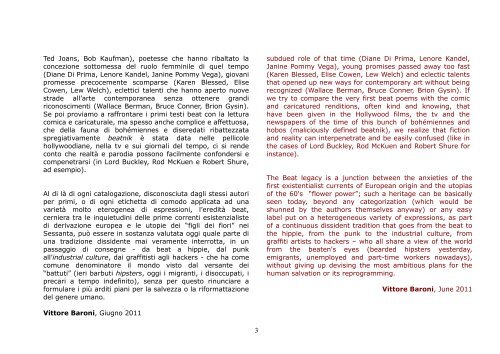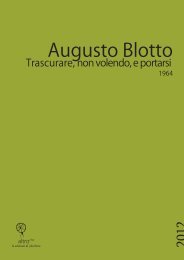You also want an ePaper? Increase the reach of your titles
YUMPU automatically turns print PDFs into web optimized ePapers that Google loves.
Ted Joans, Bob Kaufman), poetesse che hanno ribaltato la<br />
concezione sottomessa del ruolo femminile di quel tempo<br />
(Diane Di Prima, Lenore Kandel, Janine Pommy Vega), giovani<br />
promesse precocemente scomparse (Karen Blessed, Elise<br />
Cowen, Lew Welch), eclettici talenti che hanno aperto nuove<br />
strade all’arte contemporanea senza ottenere grandi<br />
riconoscimenti (Wallace Berman, Bruce Conner, Brion Gysin).<br />
Se poi proviamo a raffrontare i primi testi beat con la lettura<br />
comica e caricaturale, ma spesso anche complice e affettuosa,<br />
che della fauna di bohémiennes e diseredati ribattezzata<br />
spregiativamente beatnik è stata data nelle pellicole<br />
hollywoodiane, nella tv e sui giornali del tempo, ci si rende<br />
conto che realtà e parodia possono facilmente confondersi e<br />
compenetrarsi (in Lord Buckley, Rod McKuen e Robert Shure,<br />
ad esempio).<br />
Al di là di ogni catalogazione, disconosciuta dagli stessi autori<br />
per primi, o di ogni etichetta di comodo applicata ad una<br />
varietà molto eterogenea di espressioni, l’eredità beat,<br />
cerniera tra le inquietudini delle prime correnti esistenzialiste<br />
di derivazione europea e le utopie dei “figli dei fiori” nei<br />
Sessanta, può essere in sostanza valutata oggi quale parte di<br />
una tradizione dissidente mai veramente interrotta, in un<br />
passaggio di consegne - da beat a hippie, dal punk<br />
all’industrial culture, dai graffitisti agli hackers - che ha come<br />
comune denominatore il mondo visto dal versante dei<br />
“battuti” (ieri barbuti hipsters, oggi i migranti, i disoccupati, i<br />
precari a tempo indefinito), senza per questo rinunciare a<br />
formulare i più arditi piani per la salvezza o la riformattazione<br />
del genere umano.<br />
Vittore Baroni, Giugno 2011<br />
3<br />
subdued role of that time (Diane Di Prima, Lenore Kandel,<br />
Janine Pommy Vega), young promises passed away too fast<br />
(Karen Blessed, Elise Cowen, Lew Welch) and eclectic talents<br />
that opened up new ways for contemporary art without being<br />
recognized (Wallace Berman, Bruce Conner, Brion Gysin). If<br />
we try to compare the very first beat poems with the comic<br />
and caricatured renditions, often kind and knowing, that<br />
have been given in the Hollywood films, the tv and the<br />
newspapers of the time of this bunch of bohémiennes and<br />
hobos (maliciously defined beatnik), we realize that fiction<br />
and reality can interpenetrate and be easily confused (like in<br />
the cases of Lord Buckley, Rod McKuen and Robert Shure for<br />
instance).<br />
The Beat legacy is a junction between the anxieties of the<br />
first existentialist currents of European origin and the utopias<br />
of the 60's “flower power”; such a heritage can be basically<br />
seen today, beyond any categorization (which would be<br />
shunned by the authors themselves anyway) or any easy<br />
label put on a heterogeneous variety of expressions, as part<br />
of a continuous dissident tradition that goes from the beat to<br />
the hippie, from the punk to the industrial culture, from<br />
graffiti artists to hackers – who all share a view of the world<br />
from the beaten's eyes (bearded hipsters yesterday,<br />
emigrants, unemployed and part-time workers nowadays),<br />
without giving up devising the most ambitious plans for the<br />
human salvation or its reprogramming.<br />
Vittore Baroni, June 2011




